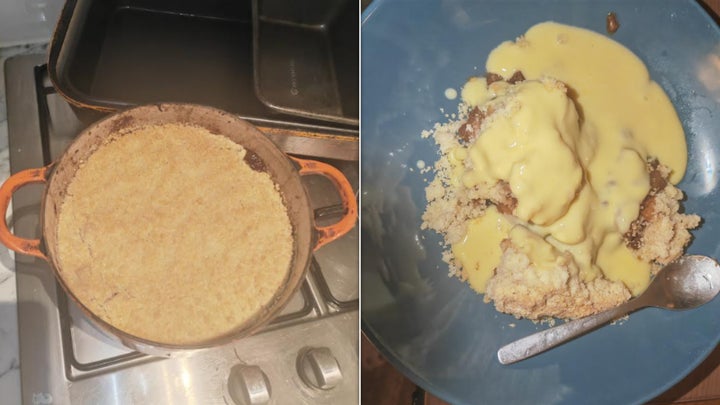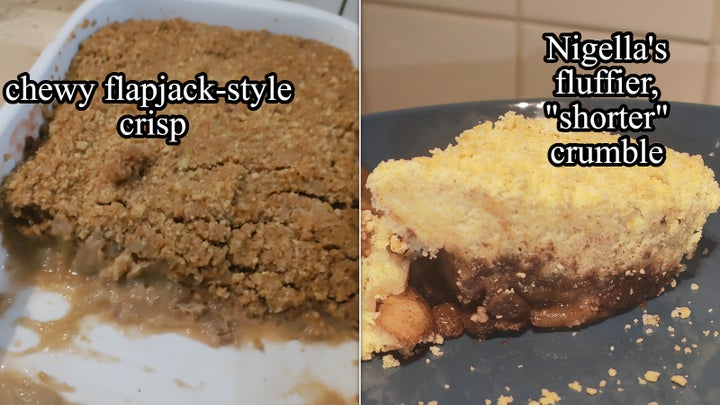If you’ve read my thoughts on carrot cake, brownies, and rocky road, you’ll know that I’m pretty strict on my baked goods.
To be honest, that’s because I don’t see the point in dirtying dishes, losing hours of my free time, and often spending more on ingredients than I would on a supermarket cake unless the result is really amazing.
Advertisement
Crumble is a rare exception. It doesn’t take long to mix fruit and sugar (for berry-based versions, I don’t even bother stewing them) and place a crown of crumbly, crunchy topping over it; even if you mess it up, the result still tastes good.
But having made over 100 of them in my life, I am no longer satisfied with “good.” I want a fall-apart topping that crumbles gently away to a shortcake-like layer at its base. I want a buttery, butty, toasty-but-not-too-intense flavour that’s so good, I could eat it by itself.
And in my extensive tests, I’ve found only Nigella’s recipe will do.

Amy Glover / HuffPost UK
Advertisement
Please, please don’t add too many special ingredients
I’ve tried adding oats to the mix (Gordon Ramsay chucks in granola or muesli for a chew, too). I’ve whacked in darker brown sugar for a more treacle-y topping, and included a range of spices.
You can see the chewiest, most flapjack-like results I’ve found below (this is the recipe if that’s what you’re after). But, at the risk of sounding grumpy and obstinate, that is not a crumble.
For that, you’ll need to stick to the classics: Nigella uses only sugar (both caster and demerara, though I’ve achieved a happy middle with granulated many times before), butter, and plain flour for the base of her crumble.
Advertisement
But because I want inches of thick crust, her added ingredient – baking soda, which introduces air to the deepest layer of the topping – is key.
She rubs the butter and flour (about 74% butter to flour, one teaspoon of baking powder per 100g flour) together before adding the sugars (half-caster, half-demerara; 60% the volume of flour) to the mix and stirring.
The result is a light, fluffy, buttery but not claggy layer that becomes increasingly pie-crust-like as you spoon deeper into it.
Advertisement
And because of the raising agent, you can dig very, very deep.

Amy Glover / HuffPost UK
Any changes I’d make?
Yes – though the baking powder does help to countenance the weight the demerara sugar adds, I actually prefer plain granulated or caster sugar.
That’s because I like mine so thick, though. If I wasn’t as interested in consuming basically nothing but crumble topping in the dessert, I’d probably love the caramel-y addition.
Advertisement
Lastly, as Nigella says, “The crumble topping can be made up to one week ahead and stored in the fridge until needed” or frozen for up to three months and taken out as needed.
I reckon that’s as good an excuse as any to do what I do; make a huge batch in one go and whip it out any time you feel a craving.










